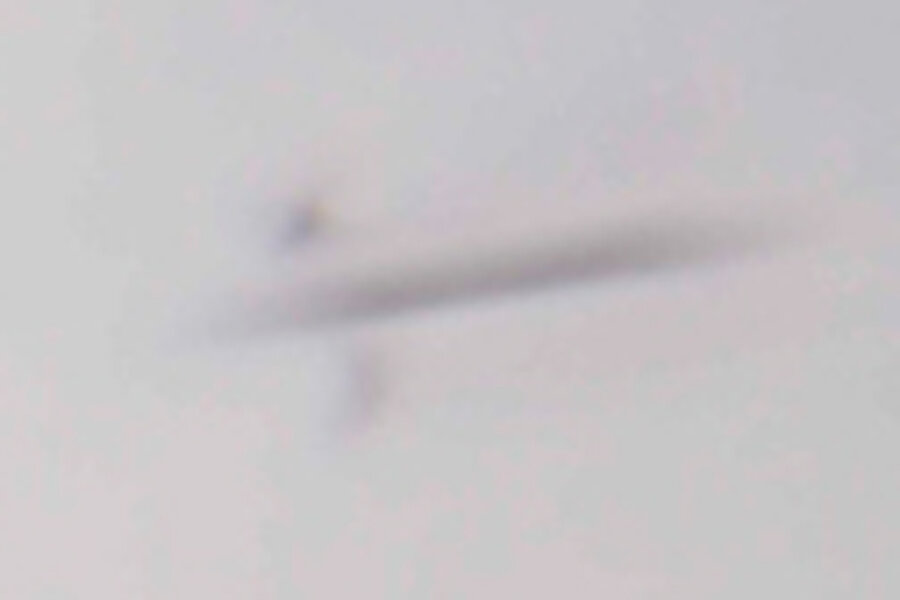Netherlands UFO: Why we want to believe
Loading...
On the last Saturday in May this year, Corinne Federer and her mother took a trip to Muiderslot Castle, a moat-girdled fortress built in 1285 at the edge of the glossy river Vecht, near Amsterdam. Fortunately, for the Internet, Ms. Federer took pictures.
When Federer later went through her photographs of the fortress, she spotted something odd, something hovering just above the cloud line: a UFO, in the classic saucer-shape, but with a single, decidedly un-aerodynamic S-shaped fin. Alien technology, for sure.
To no one’s surprise, the image – a silvery UFO caught suspended over the Netherlands’ marshy sprawl, admiring an earthly tourist attraction – went viral.
And how could it not have? UFO sightings are part of our earthly lexicon. For decades, the flying saucer has represented our shared wish to stare up at the skies and hope for something more, something probably cooler than ourselves – that, and our common suspicion of our governments and their secrets.
But the UFO is also suggestive of something else: our own biases.
The term UFO was coined in 1953, after the US Air Force decided it was time to standardize the term used to described the disks seen floating through the sky, in what was then a relatively new phenomenon. One of the earliest sightings – as such reports came to be known – was the 1947 Maury Island incident, in which a seaman claimed to have seen six saucers in Puget Sound, as though interstellar travelers had nothing better to do in all the galaxies than investigate the woodsy, northwestern United States.
The UK was perhaps the first government to hop on the UFO trend, establishing a Flying Saucers Working Party in 1950 to investigate the growing crop of claims. It concluded in 2001 that all known cases of UFOs were hoaxes or mistakes.
Today, there are a wealth of organizations worldwide devoted to campaigning for the existence of UFOs, including a group of six former US legislators who in May held a panel in Washington. on putting an end to a global “truth embargo” on the existence of alien visitors.
Of course, some UFO claims have been obvious scams – the work of Photoshop savants eager to either tease the intergalactically pious or to thumb their noses at governments, who generally have better things to do than handling War-of-the-Worlds-style inquiries. But many UFO photos have not been doctored. Those pictures – sometimes later clarified as errant weather balloons or commercial aircraft, other times never explained – are very sincerely added to a global record of alien visits to Earth. In that sense, they are genuine.
So why do we believe we see alien saucers in the sun-bathing clouds gliding outside our plane windows? And why is it that, when presented with these images of visitors from galaxies far, far away, we’re apt to believe them – or, at the very least, apt to pass them around on the Internet?
Well, maybe "The X-Files" put it best: We want to believe.
More technically, this "want to believe" is known as confirmation bias. With too much in the world for us to possibly take it all in, our minds must be selective about what they notice. And being selective means looking for evidence that fits neatly into patterns we already have. We are, in a way, great architects of our own world, builders of a little universe made up of information that confirms our current beliefs. For some people, UFOs are building blocks.
So if we don’t already believe that aliens are plying our skies or spying on us in our bathing suits, then the latest UFO picture is not going to convince us. Instead, it’s only going to become part of our belief in the brilliance of Photoshop or our conviction that the Internet is a really weird place. But if we do believe that technologically-proficient aliens exist and are interested in our teeny, reasonably undistinguished planet, then each UFO picture is validation of that belief. To believers, a new picture is received like a catalogue detailing the latest design in alien transportation, like the S-shaped addition on the most recent model. Those crafty aliens.
We’re unlikely to ever know what the slightly blurred-looking object in Federer’s photograph is. The Huffington Post interviewed Ben Hansen, a former FBI special agent and the host of the Syfy Channel's "Fact or Faked: Paranormal Files." He said that the so-called UFO is probably an insect buzzing close to the camera lens, a winged photo-bomber in the Dutch landscape.








